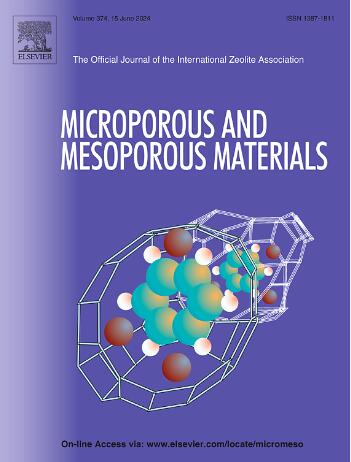Hydrogen gas adsorption capacity of halloysite nanotubes loaded with metal-organic frameworks
IF 4.7
3区 材料科学
Q1 CHEMISTRY, APPLIED
引用次数: 0
Abstract
Halloysite is a natural, eco-friendly, material abundant that has different charges inside and outside of its structural tubular nanoparticles. The adsorption performance of the material was improved by modifying halloysite nanotubes (HNTs) to prepare a nanocomposite. Metal-organic frameworks (MOF: HKUST-1) as gas adsorbents were loaded inside the halloysite to produce the composite. An etching process using sulfuric acid was performed to increase the loading efficiency by expanding the inner space of the halloysite to effectively load precursor solution; the resulting material was known as etched HNTs (EHNTs). Structural analysis was performed with X-ray diffraction (XRD), and morphological analysis was conducted using scanning electron microscopy (SEM) and transmission electron microscopy (TEM). In addition, the hydrogen and nitrogen adsorption capacities were measured using Brunauer-Emmett-Teller (BET) equipment. The results confirmed improved adsorption capacity of both N2 and H2 by HKUST-1@EHNT(5M) compared to that of HKUST-1@EHNT(1M). Etching at high concentrations allowed a larger inner space and load amount of HKUST-1. This study presented the possibility of synthesizing various hybrid materials using nanotubes, and we expect that the halloysite nanocomposite synthesis process can be used in gas adsorption applications.

负载金属有机骨架的高岭土纳米管对氢气的吸附性能
高岭土是一种天然的、环保的、丰富的材料,其结构管状纳米颗粒的内部和外部具有不同的电荷。通过对高岭土纳米管进行改性制备纳米复合材料,提高了材料的吸附性能。将金属有机骨架(MOF: HKUST-1)作为气体吸附剂装入高岭土中制备复合材料。采用硫酸蚀刻工艺,通过扩大高岭土的内部空间来有效加载前驱体溶液,提高了加载效率;由此产生的材料被称为蚀刻高碳纳米管(EHNTs)。用x射线衍射(XRD)进行结构分析,用扫描电镜(SEM)和透射电镜(TEM)进行形态分析。此外,采用BET (brunauer - emmet - teller)装置测定了其对氢和氮的吸附能力。结果表明,与HKUST-1@EHNT(1M)相比,HKUST-1@EHNT(5M)对N2和H2的吸附能力都有所提高。高浓度的蚀刻使HKUST-1的内部空间和负荷量更大。本研究提出了利用纳米管合成各种杂化材料的可能性,并期望高岭土纳米复合合成工艺可用于气体吸附。
本文章由计算机程序翻译,如有差异,请以英文原文为准。
求助全文
约1分钟内获得全文
求助全文
来源期刊

Microporous and Mesoporous Materials
化学-材料科学:综合
CiteScore
10.70
自引率
5.80%
发文量
649
审稿时长
26 days
期刊介绍:
Microporous and Mesoporous Materials covers novel and significant aspects of porous solids classified as either microporous (pore size up to 2 nm) or mesoporous (pore size 2 to 50 nm). The porosity should have a specific impact on the material properties or application. Typical examples are zeolites and zeolite-like materials, pillared materials, clathrasils and clathrates, carbon molecular sieves, ordered mesoporous materials, organic/inorganic porous hybrid materials, or porous metal oxides. Both natural and synthetic porous materials are within the scope of the journal.
Topics which are particularly of interest include:
All aspects of natural microporous and mesoporous solids
The synthesis of crystalline or amorphous porous materials
The physico-chemical characterization of microporous and mesoporous solids, especially spectroscopic and microscopic
The modification of microporous and mesoporous solids, for example by ion exchange or solid-state reactions
All topics related to diffusion of mobile species in the pores of microporous and mesoporous materials
Adsorption (and other separation techniques) using microporous or mesoporous adsorbents
Catalysis by microporous and mesoporous materials
Host/guest interactions
Theoretical chemistry and modelling of host/guest interactions
All topics related to the application of microporous and mesoporous materials in industrial catalysis, separation technology, environmental protection, electrochemistry, membranes, sensors, optical devices, etc.
 求助内容:
求助内容: 应助结果提醒方式:
应助结果提醒方式:


